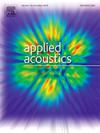Acoustic eigenvalue estimation using Rayleigh quotient iteration with a sparse matrix pencil
IF 3.4
2区 物理与天体物理
Q1 ACOUSTICS
引用次数: 0
Abstract
Various methods for estimating acoustic eigenvalues from a measured signal can be found in the literature. Among these methods, the matrix pencil method is a popular choice. The matrix pencil method provides reasonable eigenvalue estimates, albeit alongside several spurious estimates. This work uses Rayleigh quotient iteration to avoid these spurious values. Additionally, a sparse matrix structure is used to write the matrix pencil. The approach is verified using simulated data and validated using measured data. When reliable initial guesses for a few eigenvalues are available, the proposed method provides efficient and accurate eigenvalue estimates.

求助全文
约1分钟内获得全文
求助全文
来源期刊

Applied Acoustics
物理-声学
CiteScore
7.40
自引率
11.80%
发文量
618
审稿时长
7.5 months
期刊介绍:
Since its launch in 1968, Applied Acoustics has been publishing high quality research papers providing state-of-the-art coverage of research findings for engineers and scientists involved in applications of acoustics in the widest sense.
Applied Acoustics looks not only at recent developments in the understanding of acoustics but also at ways of exploiting that understanding. The Journal aims to encourage the exchange of practical experience through publication and in so doing creates a fund of technological information that can be used for solving related problems. The presentation of information in graphical or tabular form is especially encouraged. If a report of a mathematical development is a necessary part of a paper it is important to ensure that it is there only as an integral part of a practical solution to a problem and is supported by data. Applied Acoustics encourages the exchange of practical experience in the following ways: • Complete Papers • Short Technical Notes • Review Articles; and thereby provides a wealth of technological information that can be used to solve related problems.
Manuscripts that address all fields of applications of acoustics ranging from medicine and NDT to the environment and buildings are welcome.
 求助内容:
求助内容: 应助结果提醒方式:
应助结果提醒方式:


